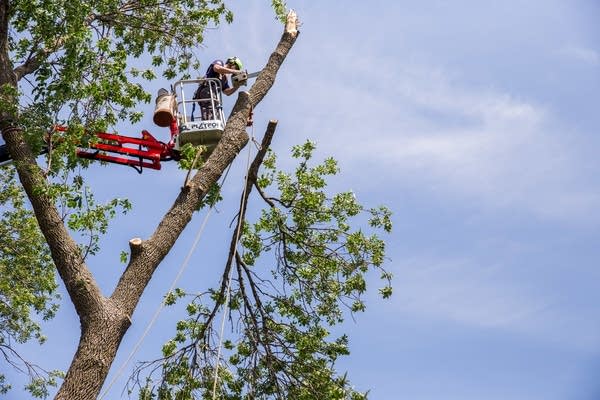At Minnesota State Fair, a last stand for ash trees?

When the Minnesota State Fair opens Thursday, fairgoers will be treated again to its great, green canopy of trees. There'll be little evidence of the struggle taking place to keep that beauty.
Behind the scenes, fair leaders have been waging a long battle to save the ash trees, which make up nearly a quarter of the fairgrounds greenery. Ashes have become endangered since the emerald ash borer entered the state seven years ago. The pernicious beetle has been destroying ash trees across the Twin Cities.
At the fairgrounds, officials have managed to keep the beetle at bay. But it's intensive work. That was clear on a recent visit as Paul Schoenike, an arborist with the Rainbow Treecare, drilled into one of the ash trees on Underwood Street, near the Agriculture Horticulture building.
The company developed a kit with stainless steel taps that push into the bark and a pressure tank to force emamectin benzoate, an insecticide, into trees to thwart the beetles. A bike pump provides the air pressure. Rainbow treats 600 ashes at the fair every other year.
Create a More Connected Minnesota
MPR News is your trusted resource for the news you need. With your support, MPR News brings accessible, courageous journalism and authentic conversation to everyone - free of paywalls and barriers. Your gift makes a difference.

The fair's ashes are a tiny fraction of the estimated 1 billion ash trees in Minnesota, which holds more than any other state. The State Fair effort runs about $40,000 every other year, in addition to treatments to keep the fair's historic elms alive, decades after the trees were all but wiped out in the Twin Cities.
Fair leaders say it's worth it. The trees help make the Minnesota fair among the nation's biggest and most successful, said fair general manager Jerry Hammer.
"There are some fair grounds that are just beautiful around the country, but for the most part, it's a lot of asphalt, a lot of large exhibit buildings, and some token greenery here or there," he said. "The kind of park-like setting we have here, trees are just ultra-critical to that, and it's pretty difficult to look around here and imagine what the fairgrounds would be like, without trees."

An answer to that can be found a few blocks away in St. Paul's St. Anthony Park neighborhood. That's where the state confirmed the bug's arrival in Minnesota in 2009. St. Anthony Park, as well as the Como Park neighborhood right outside the fair's main entrance, have been hit especially hard by the ash borer, according to Rachel Coyle, a city forester.
Trees with dead branches and sprouts at the base of their canopy have become a common sight, with chainsaws not far behind.
"You're seeing that kind of all over the city, which is kind of scary because we have over 18,000 boulevard trees left, and in the parks we're estimating there are 10,000 or so that we'll have to deal with," Coyle said. "And that's after we've done removals on the order of eight or nine thousand trees."
That could eventually make the fair, along with some suburbs that are treating ashes, one of the most prominent stands of ash trees left in Minnesota. Arborists are intensely tracking each ash tree on the fairgrounds "to make sure we don't miss anything, and keep them all healthy and going," said Russell Kennedy, a consulting arborist with Rainbow.

"The treatment's been done since 2009 here," he said, noting, "we haven't lost a tree to emerald ash borer on the fairgrounds."